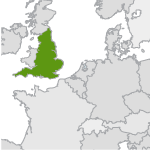Turquoise Pot
Turquoise Tankard Branded
The video begins with the making of the different canes and bands required. After these elements are rolled up on the end of a blowpipe, the open-ended cylinder is lined with colorless glass using the sbruffo method. Glassblowing is then employed to make the vessel. The handle is fashioned from excess canes left on the end of the blowpipe.
Transcript
This exceptionally complex tankard—the form is also known as a pot—is made in a number of steps. First, the canes have to be made and there are various types of canes. Then, the canes have to be attached to a blowpipe and the end closed so that glassblowing can begin. First, the canes are made. The first cane to be made is the simple white cane known as the “a fili” type. Clear glass is gathered on the end of the metal rod rolled back and forth on the metal table called the marver. When the glass is stiff enough, it's lowered into a pot of molten opaque white glass. After this stiffens, it's given yet another coating of clear glass. The intention here is to thinly coat it with clear glass at its exterior. Excess glass is pulled off the end and, after reheating, the opposite end is attached to another metal rod. The goal here is to make a cane that's about 15 or 20 feet long with a diameter of about 7 or 8 millimeters. When the cane cools, it's cut into sections.
The compound canes, known as retortoli canes, are made by putting a few white canes—a fili canes—on the outside of a large mass of clear glass melting them in and then pulling and twisting. Here the cane is only pulled to a length of about 10 feet the goal being to have a diameter of about 8 or 9 millimeters. Again, when the canes cool, they're cut into sections.
Next come the turquoise strips, or canes. A gather of clear glass is lowered into a pot of molten opaque white glass and, after this cools enough to the point of stiffness, it's lowered into a pot of transparent aqua glass. Two a fili canes are attached to opposite sides. They're preheated and quickly stick to the hot glass. After reheating and marvering to make the mass perfectly round and perfectly smooth, a spatula-like tool is used to flatten the mass. It's done so that two stripes are on the top surface and two on the bottom. This mass is then pulled into the strip. The strips are cut to length. The canes are arranged in a pattern on a ceramic surface that's been thinly coated with kiln wash. This keeps the glass from sticking when it gets hot. The canes are carefully measured and their ratio will correspond to the diameter of the post made at the end of the blowpipe.
Next, the canes are reheated and fused to the point of softness. The canes are gently pressed together to make sure they're completely joined and, when they're slightly soft, they're rolled up on the end of the blowpipe. The kiln wash has to be brushed away. The roll-up is thinly lined with a bubble of clear glass. This is the sbruffo process. After reheating and marvering to make the mass smooth and round, the end is closed. The end is finally cut free with shears, leaving a short flat array of canes. With the roll-up closed, glassblowing begins.
A combination of reheating and marvering the tip allows the glass to be inflated without the bottom becoming thin. And as the bubble gets larger, the jacks are used. The two-bladed tool are used to articulate the neck. With pulling, inflating, and jacking, the body is made and the neck is elongated. A rather narrow constriction is made about 2 inches from the end of the blowpipe. Next, the lower half is reheated. The pipe is spun so that centrifugal force will elongate the end of the bubble. And with blowing and tooling, a Roman foot is created. A constriction is made. The end flattened. A blade on either side makes the foot narrower. While holding the constriction, air is sucked out of the blowpipe and the Roman foot completed. After reheating the vessel body is given its final shape with a little blowing and tooling.
Next comes the transfer to the punty. A little bit of glass on the end of a metal rod is touched to the bottom. The neck is broken. The glass remaining on the end of the blowpipe, about 2 inches of material, will be used for the handle. The opening is reheated. On the right, the glass remaining on the end of the blowpipe is heated. The rim is given its final diameter and the shoulder and neck shaped properly. And at just about this moment, the glass canes left on the end of the blowpipe are thoroughly molten. They're attached, cut free of the blowpipe, the second attachment point is made and the process of casting off executed. You can see the thin cast-off thread at the top of the handle. And with reheating and tooling, the handle is given its final shape. And the object gotten to a uniform temperature of about 1,000 degrees Fahrenheit. At this point, it's ready to be broken free of the punty and gradually cooled, or annealed, to room temperature.
See all: Browse by Map


